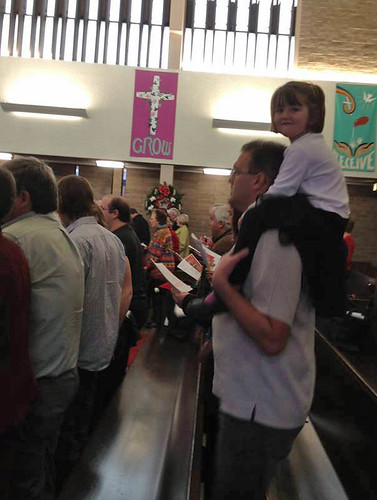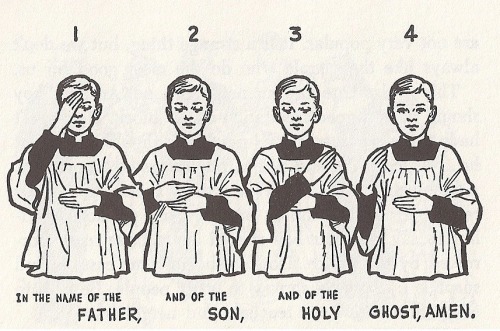
I believe that all baptized children are welcome to the Altar. The following is a guide that will hopefully help parents with bringing their children forward to receive communion.
First, for all children, it’s important to see what’s going on at the altar.
There is a drama unfolding at the the table during the liturgy and like any good drama it should be seen and heard first hand. Parents might sit in a pew closer to the front or during the meal bring your children to closer pew so they can get a better view of the altar. If moving doesn’t sound like the right decision lift up your children so they can see from were they are in the church (like this awesome dad pictured). If they can’t get a good view let them stand in the aisle. Basically, do whatever works for you so that the children can see what’s going on during the Eucharistic meal.
Children will need various reminders and help at varying stages of development. Here are some tips for each stage at a church that practices intinction (dipping the bread in the cup).
Infants
When a child attends worship after being baptized it’s appropriate for them to receive communion. Here are some how to tips for giving communion to infants who are not yet eating solid foods.
- When walking to the altar hold your infant slightly upright with your non-dominant hand.
- Receive the bread with your dominant hand.
- It’s proper to respond to the minister with an “amen.”
- Dip the bread in either the grape juice or wine so it is slightly soaked.
- Carefully give your child some of the grape juice or wine from the bread.
- Eat the remainder of the bread and wine that you were given.
- Make the sign of the cross on yourselfand on your child.

Older Infants
When an infant can support their head, eat solid food, and crawl things may change slightly when receiving communion.
- When approaching the altar hold your infant with your non-dominant hand. Remember to keep your child at leg/arm distance from the Eucharistic Minsters so that they don’t accidentally grab/kick the plate or cup.
- Show them how hold out their hand to receive the bread if they’re able.
- If not, receive the bread with your dominant hand.
- Dip the bread in either the grape juice or wine.
- Carefully give your child some of the bread and grape juice or wine.
- Eat the remainder of the bread and wine that you were given.
- It’s proper to respond to the minister with an “amen.”
- Make the sign of the cross on yourself and on your child.

Toddlers/Preschoolers
Toddlers and Preschoolers are walking, eating solid food, and able to receive communion with some assistance from you. It’s at this stage that most instruction and communication happens.
- If your toddler is willing to walk to the altar it is preferable to being held. While walking show your toddler how to extend their hands (one over the other) to receive the elements.
- Gently remind them to respond to the Eucharistic minister with an “amen” before you get to the front. If your child forgets, you might remind them by saying “amen” for them in response to the minister.
- If they’re still developing basic coordination, guide their hand when dipping either the grape juice or wine.
- Gently remind them to be gentle when dipping.
- Encourage them to make the sign of the cross after they receive both bread and wine. You can do this by taking their hand and doing it with them or by modeling it yourself.
- It is perfectly appropriate to quietly instruct your children in receiving communion reminding them they are receiving Jesus.Communion as you normally would
Older Children
By this time your child should be able to come to the Altar on their own. You should continue to coach them on how to take communion when they forget or their habits become sloppy.
Here are some reminders:
- This is a holy time and they should be mindful of their actions. This means we are quiet and orderly.
- Hold your hands out one palm over the other with closed fingers. Receive, don’t grab.
- “Amen” is the appropriate response to the Eucharistic Minister’s statements.
- Make the sign of the cross.
- Remind them they are meeting and receiving Jesus in the meal.
All Children
If your child suddenly wants to stop taking communion, won’t get in line, and throws a fit, don’t force them to come forward. You can gently encourage them, but don’t make it an issue.
I hope these are helpful tips.
Parents, what have you found to be helpful when bringing your children to communion?
Pastors, what have you found to be helpful from parents bringing their children to the Altar?
-jpserrano
